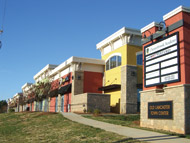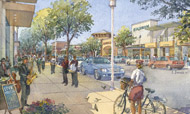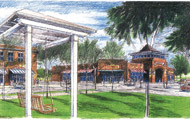|
COVER STORY, MARCH 2009
CAROLINAS RETAIL
Strong developments push forward.
Jaime Lackey & Jon Ross
Many retailers and developers in the Carolinas are hoping to weather the economic storm, but brokers predict more tenant closings before the economy improves. On the other hand, lease rates may favor smaller and new concepts — as long as they are well capitalized.
This year will see a shake out of poor concepts, weak retailers and those who are dependent on consumers’ discretionary income to keep them afloat, predicts Charles Neil of Charlotte, North Carolina-based Cornerstone Property Advisors. He explains, “In the past, many operators could simply apply for an equity line to get them through the rough times. Unfortunately, banks are not so liberal with their capital these days. It has become increasingly more difficult to secure loans even with good credit, and for those who have already maxed out their credit lines, the end may be near.”
On the tenant side, Neil says, “Lower-cost fast food seems to be holding its own along with discounters such as Family Dollar, which has been weathering the storm quite well. Big box retailers like Costco and Wal-Mart are surviving although we would have expected to see them post better earnings than we have seen so far.”
He continues, “The stronger national retailers appear focused on closing underperforming stores in order to survive the downturn. A few retailers are asking for concessions from landlords in order to continue operations. In these cases, retailers need to be ready to open their books and show a definitive downturn in their business, not just a seasonal blip in their financials.”
On the development side, there are very few new projects on the drawing boards, although developers continue to deliver projects already underway.
“There are not enough properties changing hands to understand what current cap rates are or should be,” says Eric Johnston, a retail broker with Columbia, South Carolina-based Grubb & Ellis | Wilson Kibler. “If you’re developing to sell, it is hard to put a value on land if you don’t understand the profit margin you’ll have at the end [of the development process].”
In Columbia, retailer bankruptcies have created more than 650,000 square feet of vacant big box space as Goody’s has closed three stores, Circuit City has closed two and Linens ’n Things has closed one. “From what we’re hearing, we’ll see more big box vacancy this year,” Johnston says.
 |
Old Lancaster Town Center in Charlotte, North Carolina.
|
|
There are a couple of development projects that were not derailed by the economic conditions. Lowe’s has opened a 103,000-square-foot store with a 31,000-square-foot garden center on Clemson Road in Columbia. In the Ballantyne area, a new Wal-Mart Supercenter is serving as a catalyst for development, including a shadow-anchored center and fast food restaurants. On Highway 6, Charlotte-based Centurion Partners is developing the 23,000-square-foot Colonnade at White Knoll. Ballantyne is also home to the Old Lancaster Town Center.
Benjamin Johnson, research manager with Grubb & Ellis | Wilson Kibler, notes that some areas of Columbia should see new development for grocery-anchored centers and home improvement stores once the economy picks up. Housing growth has concentrated in Lexington, the Red Bank/White Knoll area and Gilbert in the last couple of years, and retail has not yet caught up.
In the Greenville, South Carolina, area, RealtyLink has just completed Midtowne Park, a 175,000-square-foot project on Clemson Boulevard in Anderson, South Carolina. Hughes Commercial Properties Inc. is redeveloping a former BJ’s Wholesale building. The 117,000-square-foot project is located at Interstate 385 and Woodruff Road in Greenville. Academy Sports and Outdoors expects to open an 86,000-square-foot store this summer. The remaining space is available for junior anchor and small shop space.
“Greenville has never been a boom-type market. We are less affected by the slowdown than the coastal areas,” says John Jamison, principal with Greenville-based RealtyLink. He adds, “Our housing market is holding up well compared to the rest of the Southeast.”
Jamison notes that quick-service restaurants and local retailers are showing some leasing activity. Pollo Campero, a Central American restaurant company with U.S. headquarters in Dallas, will open its second location in Greer later this year. (The first location opened in Cherrydale in December.) According to Jamison, a new Bojangles franchisee is also looking to acquire restaurant space in the market.
In Charleston, South Carolina, Will Sherrod of the locally based Anchor Commercial Real Estate Services has two very different sets of advice for his clients. He says the landlords he deals with should be prepared to offer free rent, improvement allowances and other concessions in order to snare tenants. “For the tenants I represent, it’s the exact opposite,” Sherrod says. “[I tell them to] be willing to posture and play a little harder ball. You’ve got a little bit more leverage right now because there’s so much more competition and so few tenants that are willing to expand.”
The current state of Charleston retail is a stark change from the thriving market of a few years ago. But with the exit of Circuit City, Linens ‘n Things and other large retailers from the market, the ball is securely in the tenant’s court. “Tenants had been fighting over the same spaces,” he says. “Now it’s fewer tenants to compete over those available spaces.”
Unfortunately, the immediate future looks nothing like the past. The outlook for 2009 isn’t too rosy for retailers in Charleston, and Sherrod predicts the current retail development standstill won’t start to dissipate until at least 2010. Compounding the lack of new projects is the amount of space that will continue to come on the market from national and regional retailers pulling back or disappearing altogether. “For the next year, it’s hold on and ride the rollercoaster,” he says. “Hopefully we’re near the bottom and will start heading back up.”
In Wilmington, North Carolina, retail space was returning to the market through sublease opportunities and recapture through the end of 2008. Retail broker Bryan Greene expects the market to stabilize in 2009. Greene, who works with Wilmington, North Carolina-based Cape Fear Commercial, also predicts economic incentives will encourage business growth, especially in underserved categories, including specialty foods, brand apparel and outdoor lifestyle.
In the meantime, there are a number of new projects underway despite the current economic conditions. Lincoln Harris is redeveloping a former Wal-Mart shopping center at Carolina Beach Avenue and College Drive in Wilmington. Home Depot is now open at the site, which is called Myrtle Grove Shopping Center. The Mayfaire development by Brody Zimmer continues to add space for new retailers. J. Crew is one new tenant in the project’s town center. Panera Bread and Sprint recently opened in a outparcel building that is part of the project’s grocery-anchored neighborhood center. There will also be a 56-acre town center and 130,950 square feet of retail outparcel space at the master-planned Autumn Hall in Wilmington. Cape Fear Commercial is developing the project.
Charlotte has been a strong market and should weather the storm better than or as well as the rest of the country, says Charles Neil of Cornerstone Property Advisors. “Our economy is more diverse than many think. We are not just a banking city. In fact, banking and finance jobs make up just less than 8 percent of the region’s employment. Our broad-based economy should hold up, and we will bounce back quicker than most cities.”
According to Neil, “We are seeing positive leasing activity in our centers that are value oriented. Lower priced shopping centers are seeing increased activity from existing retailers who are downsizing and looking to reduce their overhead. Furthermore, we are seeing an increase in startups as people are leaving or losing their corporate jobs and looking to create their own businesses.”
The Raleigh/Durham area of North Carolina is still seeing retail projects come online. In fact, there is approximately 1.7 million square feet of retail space currently under development throughout the greater Triangle area, according to Allison Mitwol, real estate advisor with Raleigh-based Coldwell Banker Commercial TradeMark Properties.
 |
CASTO’s Park West Village in Cary, North Carolina.
|
|
In Cary, North Carolina, a suburb of Raleigh/Durham, CASTO is developing Fairview Village, which will be anchored by Bloom Supermarket. Sarasota, Florida-based CASTO Lifestyle Properties, a division of the larger company, is also developing the 100-acre Park West Village in Cary. 1st Carolina Properties of Cary and JPMorgan Asset Management-Real Estate are also involved in the project, which will bring more than 700,000 square feet of retail, 50,000 square feet of office and a 140-unit hotel to the area. Kane Realty is developing a 113,000-square-foot retail center called North Hills East in Raleigh. JSSR recently delivered a 250,000-square-foot center called Shoppes at Garner in Garner, North Carolina. There are several new developments in the Research Triangle Park area, ranging from the 35,000-square-foot Market at Perimeter Park to the 366,000-square-foot Shiloh Crossing.
 |
Austin Village will bring 65,206 square feet of retail to Indian Trail, North Carolina.
|
|
Last November, Crosland broke ground on Phase I of its 100-acre mixed-use project Austin Village in Indian Trail, North Carolina. The 19-acre first phase comprises a 65,206-square-foot retail center anchored by a Harris Teeter store, which will span 48,756 square feet.
Tenants are interested in these new developments. According to Donna Stickley, also a real estate advisor with Coldwell Banker Commercial TradeMark Properties, “Telephone and email inquiries [from potential retail tenants] have increased significantly since January 1st.” In particular, Stickley notes, “Physicians are looking for retail space as a way to increase visibility in the market and utilize locations that are in areas with high traffic counts and demographics.”
Stickley and Mitwol note that the down economy means brokers spend even more time marketing: “We will spend more time networking in front of businesses and the brokerage community, networking through commercial organizations, enhancing our e-mail campaigns and marketing through venues such as craigslist, ActiveRain and commercial real estate blogs.”
©2009 France Publications, Inc. Duplication
or reproduction of this article not permitted without authorization
from France Publications, Inc. For information on reprints
of this article contact Barbara
Sherer at (630) 554-6054.
|
